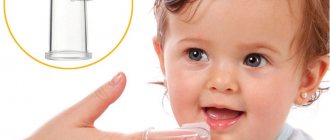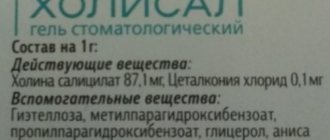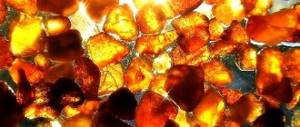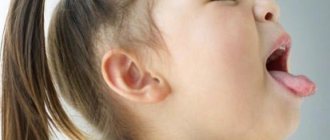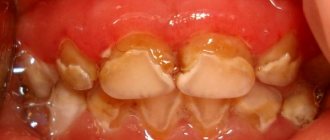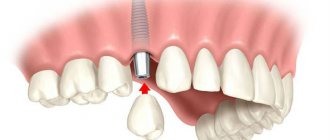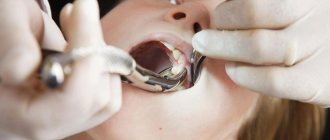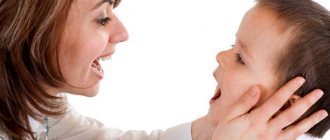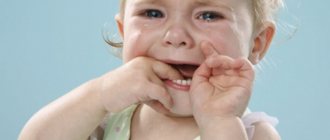Can children have a teething cough?
A child may cough while his teeth begin to grow, due to increased blood circulation in the gum area and the close proximity of the nasal cavity. Due to the inflammatory process, a runny nose appears.
Constant discomfort torments the baby, which is why he cries. This leads to an accumulation of mucus. It flows into the nasopharynx, irritates the respiratory tract, and leads to coughing attacks.
When teeth are cut, gums are injured, and profuse salivation begins. This is how the body responds to damage to the oral mucosa. Saliva also flows down the throat, causing spasms.
When teeth erupt, the immune system is greatly weakened, as a result of which the body becomes vulnerable to various diseases. Infants have a severe cough for the following reasons:
- constantly stuffy nose;
- the child has been sick for a long time;
- there is a hidden viral disease.
Parents are also concerned about the cough that occurs during teething. More often it is wet and is associated with increased salivation. It goes away without treatment after a couple of days. You can determine the natural discharge of mucus by the skin around the lips - it is irritated.
If you are teething, you may also experience a dry cough. It appears when sputum has not had time to accumulate in the lungs, and also due to the drying out of the nasopharynx due to the constant crying of the child at the initial stage of teething.
Increased saliva production
When the body begins to prepare for teething, the baby increases blood supply and circulation to the mucous membranes and gums, which irritate the teeth that are about to break through. This includes increased blood circulation in the area of the salivary glands and nasopharynx, due to which salivary secretions begin to appear in excess quantities in the child’s mouth. It is also present in the nose, and is often mistaken by parents for snot.
One of the signs of teething is increased salivation.
Saliva, among other things, is the body’s protector from bacterial attack. In young children, it does not yet possess all the enzymes that help fight harmful microorganisms, but, nevertheless, it is already able to secrete the enzyme lysozyme in small quantities, which has an anti-inflammatory and antibacterial effect. It is precisely this that is necessary for the natural fight against the inflammatory process on the mucous membrane, without which not a single tooth erupts.
Excessive amounts of saliva accumulate in the baby’s mouth, some of the saliva flows out, and some enters the gastrointestinal tract (which is why the child may experience loose stools and diarrhea). If the baby is in a lying position, then saliva enters the nasopharynx, flows down the back wall of the throat, causing irritation, and the body turns on protective mechanisms, which is why the cough and runny nose so familiar to everyone appears. But if the cause of cough and snot is determined precisely, i.e. It was drool that was to blame, so don’t give your babies expectorants; 3-4 days after teething, such symptoms will go away on their own.
Is it necessary to treat a cough on teeth?
Teething and coughing often accompany each other. This period proceeds with strong whims of the child. Children refuse to eat and cry constantly. Coughing from teeth is preceded by swelling of the gums and clenching of the jaw.
It is important to distinguish teething from a cold, since this symptom does not need to be treated. Any medications can harm a child’s body.
If you notice a wet cough due to teeth, it is recommended to monitor the child’s well-being and wait for the attacks to go away on their own. When a wet cough plagues a baby for more than 5 days, you should consult a doctor.
Rhinitis (runny nose, snot) – what is it?
The concept of a “runny nose” for ordinary people far from medicine is the appearance of mucus or snot from the nasal passages.
Sometimes clear water flows out, irritating the skin around the nose, but there are also more “alarming” snot, for example, yellow, green, white, mixed with blood.
From a medical point of view, a runny nose is an inflammatory process in the nasal cavity, accompanied by swelling, redness of the mucous membrane and discharge of various types. The cause of this condition is pathogenic microorganisms - viruses, bacteria, fungi and others. The symptoms of rhinitis are directly related to the cause; the more aggressive the bacteria or allergen, the stronger the manifestations of the disease.
At the onset of rhinitis, as a rule, liquid snot and frequent sneezing appear.
The child scratches his nose, rubs his eyes, whines. Sometimes a runny nose begins with nasal congestion, and discharge comes a day later from the onset of the inflammatory process.
It is problematic for infants to perform sucking movements, because the nose “can’t breathe”, and older children refuse to eat. During nasal congestion, the sense of smell sharply deteriorates, so food becomes tasteless for babies.
Some parents treat the runny nose negligently, not considering it a disease, saying that seven days will pass and the snot will disappear. So where do sinusitis and other complications come from? The answer is simple - from an untreated runny nose.
Parents should definitely monitor the child and evaluate the nature and color of the snot. Nasal congestion should be addressed urgently, because... You can get a complication such as otitis media.
When you urgently need a doctor and immediate help at home
Coughing during teething is almost always accompanied by copious amounts of saliva and snot. If the nasal secretion changes consistency, color, turns yellow or green, or congestion appears, you should contact your pediatrician. The following symptoms are also a reason to consult a doctor:
- A dry cough accompanied by convulsive attacks and lasting more than 6 minutes may indicate whooping cough.
- A sharp attack of barking cough during sleep often indicates laryngitis.
- Difficulty breathing with shortness of breath and wheezing in the chest is a sign of pneumonia.
- High body temperature (more than 38°C) is a sign of acute respiratory viral infection, influenza or other diseases.
- Redness of the throat, the appearance of a white coating or ulcers are often a symptom of a sore throat.
If such signs intensify and the child’s condition worsens, it is necessary to urgently call an ambulance.
How does a runny nose occur (stages of rhinitis)
Otolaryngologists, in the diagnostic process, distinguish the following stages of inflammation of the nasal mucosa:
- The first stage lasts a short period of time, usually half a day, or a day at most. The child begins to rub and wrinkle his nose and sneeze. Older children report itching in the nose, sometimes dryness, and burning. They complain of headache, fever, fatigue. The main symptom of this stage is severe itching in the nose;
- the second stage lasts 2–4 days . The disease is at its peak. Rhinitis can manifest itself in a rapid course, covering all sorts of symptoms, including increased body temperature, or it can proceed calmly, without much annoyance to the child. It all depends on the cause of the runny nose and how well the snot is treated.
High temperature during rhinitis, especially in the first days of illness, most often indicates an acute viral infection. By the fourth day, with proper therapy, acute symptoms subside, the child’s condition improves, the nose is less stuffy, the nasal tone disappears, and snot accumulates periodically;
- the third stage is the period of resolution of the runny nose (begins after the fourth day of illness). The snot gradually recedes, and every day it becomes easier to breathe through the nose. Sometimes the snot becomes yellowish in color. Here it is necessary to monitor the nature of the snot, perhaps it is thickened residual snot, but it is possible that bacterial microflora is attached.
How to help your child with a cough
When a baby's teeth are teething and this is accompanied by a cough, traditional methods will help. Strong medications cannot be given without signs of illness. Expectorant medications are also ineffective, since a baby under one year old cannot yet cough up sputum.
It is necessary to carefully monitor the child’s condition, give more breastfeeding (if he is breastfed), and put him to bed more often. If he wakes up coughing, you can raise his head a little to solve the problem.
Traditional methods
If a child under one year of age has a cough, any alternative means should be used with great caution, as they can cause allergies. It is advisable to consult a doctor.
It is good to give your child herbal infusions or children's teas (with chamomile, raspberries, rose hips), but not more than 1 tbsp. three times a day.
If the baby is not allergic to honey, you can lubricate the gums with it. It has an anti-inflammatory and disinfecting effect.
Compresses help with coughs. They should not be done at elevated body temperatures. Here are some effective formulations:
- Flour, sunflower oil, mustard powder, and vodka are mixed in equal proportions. The mixture is divided into 2 parts, each of which is laid out on different towels. Compresses are placed on the chest and back and secured. The child is dressed in warm clothes. The compress is removed after 2 hours.
- Take warm boiled potatoes, put them in a bag, wrap them in a towel, apply them to the chest area, and leave for 60 minutes.
Massaging the child’s back can also help relieve an attack. It must be done carefully, with smooth movements in the direction from the lower back to the neck, bypassing the spine area.
Medicines
All parents who are faced with a cough in a child at the time of teeth growth are interested in how to treat it and what is suitable from pharmaceutical products. Since attacks appear as a result of large drooling and runny nose, all treatment should be aimed at regularly moisturizing the nasal mucosa and eliminating mucus.
You can moisten your baby’s nose with a regular saline solution or pharmaceutical drops with sea water (Aqualor Baby, Aquamaris, Salin). They relieve irritation and swelling, wash away snot.
Rinse the nose as follows:
- The child is placed reclining.
- The head is turned to the side, 3-5 drops of solution are dripped into each nostril.
- Take a bulb or a special nasal aspirator, insert it into the nasal passage, close the second nostril with your finger, and suck out the snot.
- The same manipulation is carried out with the other nostril.
To make your gums hurt less, you can use special ointments (Kamistad, Kalgel, Pansoral). Sometimes Dentokid tablets are prescribed, which need to be dissolved in water. They relieve pain well, have an antiseptic effect, and prevent increased salivation during tooth growth. Apply up to 4 times a day.
Other ways to relieve the condition
A baby's cough, which is caused by tooth growth, does not require therapy. The main thing is to monitor how the child feels. To make your gums hurt less, you can massage them lightly and let your baby chew a chilled teether. It is also important to follow some preventive measures:
- Ventilate the room more often.
- Give your child more water, which prevents the mucous membrane from drying out.
- Don't force your child to eat if he doesn't want to.
- Place a small pillow under the head to prevent mucus from draining into the nasopharynx.
- Don't give up breastfeeding. It is better to wait for the teeth to grow, and only then curtail lactation.
- Do not wrap the child so that the body temperature does not increase.
- Walk outdoors more often.
A good purchase is a humidifier that maintains optimal indoor air humidity (40-65%). Thanks to it, breathing is normalized, the outflow of snot and sputum is improved, and the child’s body independently fights bacteria and viruses.
Questions that concern parents
Some parents experience a longer cough in their baby. At the same time, there are no other signs of the disease: the lungs are clean, the throat is not red, there is no temperature. Pediatricians call this severe teething syndrome. In this case, coughing attacks either arise or go away on their own.
This can last until all the teeth come out. It is important to consult your pediatrician regularly so as not to miss the negative effects.
During the teething process, complications sometimes occur, which are accompanied by cough, high fever, and inflammation of the lymph nodes. This can happen if the gum does not rupture, but remains above the tooth, as a result of which blood stops flowing to it and necrosis forms. If, in addition to coughing, parents observe similar symptoms, they should immediately consult a doctor.
When a baby develops a cough without other visible symptoms, doctors often associate this symptom with teeth. However, it can be caused by allergies.
Allergens include dust, animal hair/saliva, washing powder or cosmetics, flowering indoor plants, improperly selected mixture or food.
In this case, the cough is accompanied by swelling in the nose, severe runny nose, skin rash, and increased lacrimation. To eliminate such symptoms, antihistamines are prescribed, for example, Fenistil, Zyrtec, Suprastin.
Nasopharyngeal sore throat
Although this is a fairly rare disease, it does occur. Only an experienced otolaryngologist can diagnose this disease, but you can suspect it if you have the following symptoms:
- Severe nasal congestion. It can be so progressive that not a single classic vasoconstrictor drug like Naphthyzin is able to cope with it;
- Yellow discharge that does not need to be blown out - there is so much of it that it flows out on its own. At the same time, the baby feels very strong discomfort;
- The high temperature remains stable even with the use of strong antipyretic drugs. Usually it reaches 38-39⁰, but it can be knocked down by only 1-1.5 positions. When bringing down the temperature, it is important to remember that no remedy with an antipyretic effect should be used more often than every 8 hours;
- Night cough associated with the fact that mucus from the nasal cavity falls into the nasopharynx - in fact, this is a reflex act;
- Symptoms also include nasal congestion, loss of appetite, weakness, and malaise.
Since the cause of this disease is pathogenic streptococci, therapy is quite strict. This is due to the fact that it is necessary to remove the symptoms of the disease as soon as possible and rid the child’s body of the pathogens. Therapeutic measures include:
- Treatment with antibiotic drugs. As a rule, they are administered intravenously, since the speed of their action in this case increases several times.
- Drink plenty of fluids, which helps the body quickly remove toxic metabolic products.
- Rinsing the nose with physiological or saline solution, which will help improve nasal breathing. The manipulation should be carried out at least 8 times a day.
- For local treatment, nasal drops with antibiotics to which the specific strain of streptococcus is sensitive should be used.
- How to treat thick snot in a child? Komarovsky: a child has a runny nose
